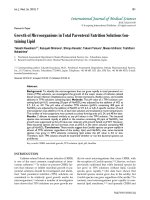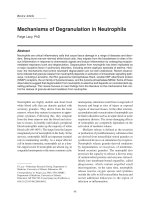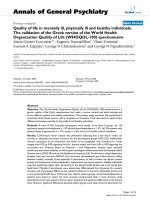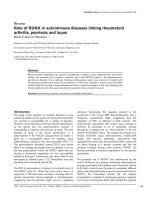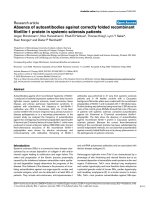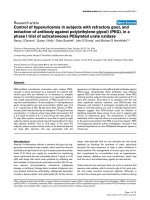Báo cáo y học: "Absence of seroreversion in 80 HAART-treated HIV-1 seropositive patients with at least five-years undetectable plasma HIV-1 viral load." pot
Bạn đang xem bản rút gọn của tài liệu. Xem và tải ngay bản đầy đủ của tài liệu tại đây (210.75 KB, 3 trang )
BioMed Central
Page 1 of 3
(page number not for citation purposes)
AIDS Research and Therapy
Open Access
Short report
Absence of seroreversion in 80 HAART-treated HIV-1 seropositive
patients with at least five-years undetectable plasma HIV-1 viral
load
Marion Cornelissen
1
, Suzanne Jurriaans
1
, Jan M Prins
2
, Margreet Bakker
1
and
Antoinette C van der Kuyl*
1
Address:
1
Department of Human Retrovirology, Academic Medical Centre, University of Amsterdam, Amsterdam, The Netherlands and
2
Department of Internal Medicine, Division of Infectious Diseases, Tropical Medicine and AIDS, Academic Medical Centre, University of
Amsterdam, Amsterdam, The Netherlands
Email: Marion Cornelissen - ; Suzanne Jurriaans - ; Jan M Prins - ;
Margreet Bakker - ; Antoinette C van der Kuyl* -
* Corresponding author
Abstract
Partial or complete seroreversion for HIV-1, or incomplete antibody evolution are relatively rare
events that have so far only been described in patients treated with HAART early after virus
infection. Whether seroreversion is seen in patients treated effectively with HAART years after
their acute infection has not been investigated so far. Therefore we have investigated anti-HIV
antibody levels in 80 patients treated with HAART during chronic HIV-1 infection, who had an
undetectable HIV-1 plasma viral load for at least five years. In none of the patients we observed
seroreversion, and there was also no significant decrease or increase in antibody levels in this group
of patients. So, successful HAART treatment during chronic HIV-1 infection does not induce
seroreversion.
Findings
Seroreversion, defined as a quantitative decrease in spe-
cific antibody levels so that they measure below the cutoff
of an assay, can be partial, resulting in the loss of response
against one or a few antigens, or complete, with loss of
total antibody reactivity. In HCV infection, seroreversion,
which is found in 16–23% of the patients, has been asso-
ciated with virus clearance, but it can also be observed in
chronic HCV infection [1,2]. HCV seroreversion can occur
spontaneously, in association with immune-suppression,
or after antiviral treatment [3]. HCV seroreversion is often
transient, suggesting that antibody levels fluctuate around
the cutoff of the assay [2]. In HIV infection, both partial
and complete seroreversions are rare. Apart from being
documented in non-infected babies of seropositive moth-
ers due to loss of maternal antibodies [4-6], seroreversion
was seen in late-stage AIDS patients [7], in neonates
treated very early with HAART [8], and in patients treated
with antiviral therapy during acute infection [9-11]. In
these patients, some seroreversions were partial (incom-
plete evolution of the western blot pattern), and some
were complete (negative in an HIV-1/2 ELISA). Transient
seroreversion has been reported in a single HIV-1 infected
patient [12]. The clinical significance of HIV seroreversion
is unclear [13,14], as is the frequency of seroreversion in
chronic HIV-1 infection. It could be assumed that a loss of
antibody response is related to a loss in antigenic stimuli,
suggesting that seroreversion indicates an absence of viral
Published: 16 February 2006
AIDS Research and Therapy 2006, 3:3 doi:10.1186/1742-6405-3-3
Received: 19 December 2005
Accepted: 16 February 2006
This article is available from: />© 2006 Cornelissen et al; licensee BioMed Central Ltd.
This is an Open Access article distributed under the terms of the Creative Commons Attribution License ( />),
which permits unrestricted use, distribution, and reproduction in any medium, provided the original work is properly cited.
AIDS Research and Therapy 2006, 3:3 />Page 2 of 3
(page number not for citation purposes)
replication. Indeed, HCV seroreversion is accompanied in
many cases by the absence of viral RNA as detected by
PCR, although in many other viral infections, clearance of
the virus does not induce loss of antibodies. Over the last
decade, treatment of HIV infected patients with antiviral
drugs often results in long-term undetectable HIV viral
load in plasma. Viremia in untreated patients probably
results from both active replication as well as release of
HIV-1 RNA from stable reservoirs, e.g. memory T-cells,
while in treated patients there is only low-level viral RNA
release from these reservoirs (reviewed by [15]). Cur-
rently, there is no evidence suggesting that clearance of
HIV is achievable, and attempts at viral eradication have
failed so far [15]. Even in treated patients with long-term
undetectable plasma viral load, transient elevations of the
viral load into the detectable range of the assay, so-called
blips, are common. So, it is likely that even HIV-1 infected
patients with optimal treatment response experience low-
level HIV-1 activity, which would preclude seroreversion.
However, it cannot be excluded that patients with no rep-
lication of HIV do exist in this patient group.
To examine the effect of long-term undetectable plasma
HIV-1 levels upon the serological response, we have ana-
lysed the HIV-1/HIV-2 antibody levels in 80 patients
treated with HAART resulting in at least a five years unde-
tectable plasma viral load (<50 copies/ml) without blips
> 400 copies/ml. Forty-four patients (55%) had an unde-
tectable HIV-1 load for more than 7 years. Fifty patients
showed one or two blips of ≤ 400 copies/ml during these
years, thirty patients experienced no blips. Presumably,
patients with blips have a higher mean residual viremia
than patients without blips [16]. Plasma HIV-1 RNA was
measured using the VERSANT HIV-1 RNA 3.0 assay
(bDNA) (Bayer Diagnostics Division, Tarrytown, NY,
USA), which has a detection level of 50 copies/ml. Plasma
HIV-1 RNA levels were determined every four months for
at least 8 years (since the start of HAART) in this patient
group. The HIV-1 antibody ratio in serum was measured
with the IMx System (IMx System HIV-1/HIV-2 III Plus,
ABBOTT Laboratories, Abbott Park, Il, USA) in the sam-
ples prior to the start of HAART, and five years later. The
reagents used in the HIV IMx assay include recombinant
HIV transmembrane glycoproteins (expressed in E. coli
and B. megaterium), HIV-1 p24 (expressed in E. coli), and
synthetic peptides from HIV-1 gp41 and HIV-2 gp36. This
assay is available as a qualitative test, but is in fact a kinetic
assay whereby increasing amounts of a product are
formed with time, and are monitored at multiple points
(personal communication, ABBOTT Laboratories), sug-
gesting it can be used as a semi-quantitative analysis.
All patients tested HIV seropositive at baseline and after at
least five years of undetectable plasma HIV-1 load, irre-
spective of the occurrence of blips. Table 1 summarizes
the IMx antibody measurements for all patients. No sig-
nificant difference in antibody levels was seen after five
years of HAART (average IMx ratio = 34.87 at the start of
HAART, average IMx ratio = 34.93 after five years, p =
0.95). Separating the groups with and without blips did
not reveal either any significant difference in IMx ratio
after five years of treatment (Table 1). Although no patient
showed evidence for seroreversion, there were 37 (46%)
patients in total with a decrease in IMx ratio after five years
of HAART, without a significant difference between the
blip group (19 out of 50 patients (38%), average decrease
in IMx ratio of 8.58) and non-blip group (18 out of 30
patients (60%), average decrease in IMx ratio of 6.36, p-
value = 0.056 (chi-square test) for patients numbers with
decreasing antibody levels in each group).
From this study it is clear that seroreversion is not com-
mon in HIV infection, not even after the achievement of
prolonged low plasma HIV-1 RNA levels, as it was not
seen in our group of 80 patients with long-term undetect-
able HIV-1 load. Earlier observations on HIV serorever-
sion suggested that seroreversion could occur when
HAART is given during acute infection. Our study suggests
that HAART given during chronic infection does not
induce seroreversion. As seroreversion has been associ-
ated with viral clearance, its absence during successful
HAART treatment possibly reflects the low level HIV-1
replication in these patients.
Competing interests
The author(s) declare that they have no competing inter-
ests.
Table 1: HIV-1 antibody measurements in HIV-1 infected patients with ≥ five-years undetectable viral load
Group N = Average IMx ratio
1
at start of HAART, ± st
dev (range)
Average IMx ratio ≥ 5 years undetectable
viral load, ± st dev (range)
P-value
2
Patients without blips 30 37.48 ± 9.93 (16.83–52.33) 36.02 ± 7.79 (17.25–45.46) P = 0.95
Patients with 1–2 blips 50 33.30 ± 9.27 (13.08–53.39) 34.27 ± 7.56 (15.22–47.59) P = 0.29
All patients 80 34.87 ± 9.68 34.93 ± 7.65 P = 0.46
1
Antibody levels are calculated as ratios of the sample rate divided by the cutoff (= negative control). A sample is considered non-reactive if the
ratio <1, and reactive when the ratio ≥ 1. The assay cutoffs are determined at each run, and vary slightly per assay and over time.
2
Two-tailed student's t-test.
Publish with BioMed Central and every
scientist can read your work free of charge
"BioMed Central will be the most significant development for
disseminating the results of biomedical research in our lifetime."
Sir Paul Nurse, Cancer Research UK
Your research papers will be:
available free of charge to the entire biomedical community
peer reviewed and published immediately upon acceptance
cited in PubMed and archived on PubMed Central
yours — you keep the copyright
Submit your manuscript here:
/>BioMedcentral
AIDS Research and Therapy 2006, 3:3 />Page 3 of 3
(page number not for citation purposes)
List of abbreviations
HCV: hepatitis C virus. HIV: human immunodeficiency
virus. AIDS: acquired immunodeficiency syndrome.
HAART: highly active antiretroviral therapy. ELISA:
enzyme-linked immunosorbent assay.
Authors' contributions
MC conceived of the study, and participated in its design
and coordination, SJ carried out the immunoassays and
participated in the design of the study, JMP is the treating
physician who collected the samples, MB selected the
patients for the study, and ACvdK participated in the
design of the study, carried out the statistical analyses and
drafted the manuscript. All authors read and approved the
final manuscript.
Acknowledgements
There was no specific funding for this study.
References
1. Lanotte P, Dubois F, Le Pogam S, Guerois C, Fimbel B, Bacq Y, Gruel
Y, Goudeau A, Barin F: The kinetics of antibodies against hepa-
titis C virus may predict viral clearance in exposed hemo-
philiacs. J Infect Dis 1998, 178:556-559.
2. Marinho RT, Pinto RM, Santos ML, de Moura MC: Lymphocyte T
helper-specific reactivity in sustained responders to inter-
feron and ribavirin with negativation (seroreversion) of anti-
hepatitis C virus. Liver Int 2004, 24:413-418.
3. Lefrere JJ, Guiramand S, Lefrere F, Mariotti M, Aumont P, Lerable J,
Petit JC, Girot R, Morand-Joubert L: Full or partial seroreversion
in patients infected by hepatitis C virus. J Infect Dis 1997,
175:316-322.
4. Lepage P, P. VP, Simonon A, Msellati P, Hitimana DG, Dabis F: Tran-
sient seroreversion in children born to human immunodefi-
ciency virus 1-infected mothers. Pediatr Infect Dis J 1992,
11:892-894.
5. Chantry CJ, Cooper ER, Pelton SI, Zorilla C, Hillyer GV, Diaz C:
Seroreversion in human immunodeficiency virus-exposed
but uninfected infants. Pediatr Infect Dis J 1995, 14:382-387.
6. Bakshi SS, Tetali S, Abrams EJ, Paul MO, Pahwa SG: Repeatedly pos-
itive human immunodeficiency virus type 1 DNA polymer-
ase chain reaction in human immunodeficiency virus-
exposed seroreverting infants. Pediatr Infect Dis J 1995,
14:658-662.
7. Gutierrez M, Soriano V, Bravo R, Vallejo A, Gonzalez-Lahoz J: Seror-
eversion in patients with end-stage HIV infection. Vox Sang
1994, 67:238-239.
8. Hainaut M, Peltier CA, Goetghebuer T, Van der LD, Marissens D, Zis-
sis G, Levy J: Seroreversion in children infected with HIV type
1 who are treated in the first months of life is not a rare
event. Clin Infect Dis 2005, 41:1820-1821.
9. Lafeuillade A, Poggi C, Tamalet C, Profizi N, Tourres C, Costes O:
Effects of a combination of zidovudine, didanosine, and lam-
ivudine on primary human immunodeficiency virus type 1
infection. J Infect Dis 1997, 175:1051-1055.
10. Jurriaans S, Sankatsing SU, Prins JM, Schuitemaker H, Lange J, van der
Kuyl AC, Cornelissen M: HIV-1 seroreversion in an HIV-1-sero-
positive patient treated during acute infection with highly
active antiretroviral therapy and mycophenolate mofetil.
AIDS 2004, 18:1607-1608.
11. Kassutto S, Johnston MN, Rosenberg ES: Incomplete HIV type 1
antibody evolution and seroreversion in acutely infected
individuals treated with early antiretroviral therapy. Clin
Infect Dis 2005, 40:868-873.
12. Zaaijer HL, Bloemer MH, Lelie PN: Temporary seronegativity in
a human immunodeficiency virus type 1-infected man. J Med
Virol 1997, 51:80-82.
13. Connick E: Incomplete antibody evolution and seroreversion
after treatment of primary HIV type 1 infection: what is the
clinical significance? Clin Infect Dis 2005, 40:874-875.
14. Crabb C: Seroreversion in patients receiving HAART during
acute infection 2. AIDS 2005, 19:N1-N2.
15. Siliciano RF: Scientific rationale for antiretroviral therapy in
2005: viral reservoirs and resistance evolution. Top HIV Med
2005, 13:96-100.
16. Di Mascio M, Markowitz M, Louie M, Hurley A, Hogan C, Simon V,
Follmann D, Ho DD, Perelson AS: Dynamics of intermittent
viremia during highly active antiretroviral therapy in
patients who initiate therapy during chronic versus acute
and early human immunodeficiency virus type 1 infection. J
Virol 2004, 78:10566-10573.


